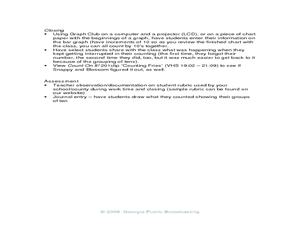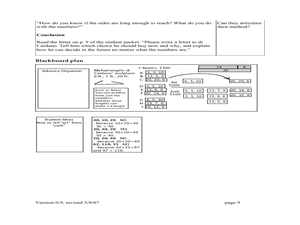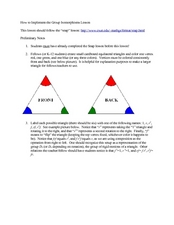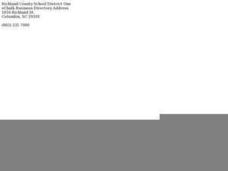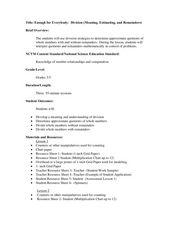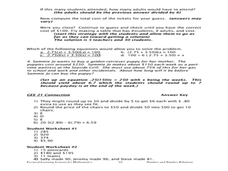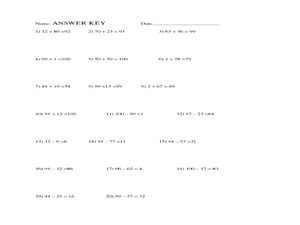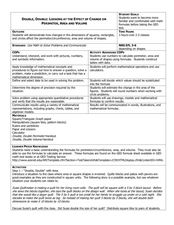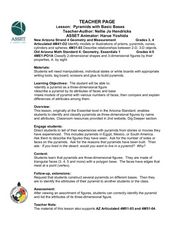Curated OER
An Easier Way to Count: Using Groups of 10
Students explore their counting skills. In this counting lesson, students group objects in sets of 10 to practice counting them. Students also practice graphing the sets of objects they count. This lesson incorporates the use a video...
Curated OER
Name Collections with Craft Sticks
Groups of Kindergarten students count craft sticks in different groups and name how many they have. They complete simple addition to ten with the use of manipulatives.
Curated OER
Justifying Answers
Young scholars study story problems and learn how to find and justify their answers. They will use a story problem and then respond to the prompt questions from the teacher. They must add and subtract facts to 6 and learn how to justify...
Curated OER
Art or Junk? Discovering the Triangle Inequality
Middle schoolers study the triangle inequality. They will identify, compare, and analyze attributes of two and three-dimensional shapes. Then they develop vocabulary to describe the attributes. They also use manipulatives to analyze the...
Curated OER
Group Isomorphisms
Students identify and apply properties of triangles. For this geometry lesson, students define equilateral triangles by sides and angles. They build cardboard triangles as they study properties of triangles.
Curated OER
Graphing Quadratic Equations
Review the form of a quadratic function, and the parabola it creates. Continue on with the whole group to work through a mini-lab, practicing how to graph quadratic equations with one variable. The goal of this lesson is for the group...
Curated OER
Operations with Fractions and Decimals
Complete a lesson plan that introduces and explores operations with fractions and decimals. Pupils estimate the reasonableness of a decimal computation. Then discuss what operation is needed to find an answer. Handouts, web sources, and...
Pennsylvania Department of Education
Shapes Around Us
Learners use manipulatives to study shapes. They sort shapes and use correct geometric terminology to describe them. Students find real-life examples of 2 and 3 dimensional shapes, and classify figures in their classroom according to...
Curated OER
Linear Equations
This is a great lesson from start to finish. With partners and on their own, learners write and solve linear equations and inequalities. They use manipulatives, group work, and an included worksheet to make magic with their problem...
Curated OER
Direct, Inverse, And Joint Variation
Students engage in a lesson that has them practice solving equations using multiplication and division. They practice solving problems using the properties needed and then students practice changing word problems into an equation.
Curated OER
Antacid Tablet Race
Young scholars complete experiments to determine how rocket fuel is affected by surface area and temperature. They compare the reaction rates of antacid tablets. They discuss their results to complete the lesson.
Curated OER
Kinzi Deaf Alumni
Learners use data of school alumni to create a database. The lesson uses technology and access to a computer lab is essential. The concepts of graphing statistics is also used to help teach across the curriculum.
Curated OER
Problem Posing Mathematics
Students work on multiplication problems. In this hands-on math activity, students practice the concept of multiplication through manipulatives, arrays, pictures, and drawings. They discover other ways of learning multiplication besides...
Curated OER
Cookie Fractions
First graders demonstrate how to use cookies to create different fractions. For this math lesson, 1st graders build their knowledge based on what they hear after the teacher reads Eating Fractions by Bruce McMillan by cutting a cookie in...
Curated OER
Piggin' out with Money
Third graders manage money. In this money math activity, 3rd graders read Pigs Will be Pigs. Students then use manipulatives to practice adding monetary amounts and making change. Students also practice working with money on selected...
Curated OER
Enough for Everybody: Division
Students study division. In this math lesson, students arrange manipulatives into equal groups. Students discuss the relationship between multiplication and division.
Curated OER
Independent Investigation
Students classify objects. For this math lesson, students sort and classify objects based on their characteristics. Students identify characteristics of objects.
Curated OER
Investigation - The Bakery Shop
Students participate in mathematical music and subtraction using their fingers when indicated in the song. In this music/math lesson, students count their fingers and pretend their fingers are cookies. Students sing the song and put a...
Curated OER
Point Graphs
Students experiment with point graphs. In this math lesson, students are divided into groups and perform an experiment to see how high a ball bounces, recording their results on a point graph. Students then answer provided questions.
Curated OER
Operations for Problem-Solving
Students examine a problem and develop the best method to arrive at the solution. In this math lesson plan, students apply basic math skills by coming up with the correct steps to solve a word problem. Students estimate solutions as...
Curated OER
Candy Addition and Subtraction
Students practice computation. In this addition and subtraction math lesson, students count M & Ms and Skittles to answer math problems and complete a related worksheet.
Curated OER
Double, Double: Looking at the Effect of Change on Perimeter, Area and Volume
Students explore perimeter, volume, and area. In this math lesson, students explore how changes in dimensions of geometric shapes affect the perimeter, area and volume of the various shapes. Students investigate the results when the...
Curated OER
Charging Up, Charging Down: Exponential Models
Students collect and analyze voltage data. In this math lesson, students investigate exponential functions using the TI and a Voltage Probe. They graph their data and analyze it using a table.
Curated OER
Pyramids with Basic Bases
Students explore pyramids. In this math lesson, students discuss where they have seen examples of pyramids. Students classify pyramids as three-dimensional figures and identify their attributes.


